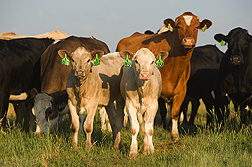DNA Fingerprinting Promotes Health and Safety
In December 2003, ARS scientists at the Roman L. Hruska U.S. Meat Animal Research Center (USMARC) in Clay Center, Nebraska, used DNA markers to confirm the Canadian origin of the first U.S. case of bovine spongiform encephalopathy (BSE). The incident demonstrated the necessity of instituting a rapid way to identify animals at every level of production—to protect U.S. agriculture and to reduce the economic and social impacts of a disease outbreak.
The ability to determine an animal’s identity is essential for controlling diseases and monitoring imports and exports. Brands, tattoos, tags, and implants are often used to identify cattle, but these labels can be damaged, altered, or lost. Retinal scans are gaining popularity. But all these forms of identification are lost at slaughter.
Fortunately, there is another approach to verify identity and trace individual cuts of meat back to the animal: DNA.
DNA-based technology is an effective complement to physical markers and can clearly identify animals in situations where physical markers cannot. Using genetic markers, scientists generate molecular fingerprints to match multiple samples from one individual.
Since 2003, USMARC researchers have identified thousands of markers and placed them in the public domain, where they can be accessed by researchers around the world.
DNA can be obtained and analyzed from cattle at any stage of life, as well as from fresh, frozen, or cooked products. It’s stable and unique to each animal.
“It’s the best way to confirm other methods of animal identification,” says William W. Laegreid, research leader of USMARC’s Animal Health Research Unit.
The most common type of genetic marker present in U.S. beef and dairy cattle is known as a “single nucleotide polymorphism” or SNP. The USMARC researchers are developing more than 120 highly specialized parentage SNPs to assist in difficult traceback scenarios. They have already identified more than 120 and annotated more than 1,600 neighboring SNPs, which improve the accuracy of assays and identification tests, says microbiologist Michael P. Heaton.
In the 2003 BSE case, U.S. and Canadian scientists used parentage analysis, which involves testing DNA samples for patterns that are consistent with parent-offspring relationships. Using SNPs to match two samples from one animal is easier and more accurate, but those samples are not always available, says Laegreid. Every addition to the genetic database improves the precision of these tests.
USMARC researchers have placed more than 7,000 SNPs in publicly available databases like dbSNP and GenBank, aided by scientists at the ARS Henry A. Wallace Beltsville [Maryland] Agricultural Research Center, the University of Alberta, the University of Louisville, and National Center for Biotechnology Information.
“Technology currently exists to identify every bovine in the United States with DNA markers,” Heaton says. “Like computer technology, price and availability will improve with time and increased demand.”
Over the last decade, technological advances have made SNP identification easier and cheaper. Today the procedure typically costs about 2 cents to 20 cents per sample, but scientists hope it will decrease to less than 1 cent.
“If done on a grand scale, DNA fingerprinting of a calf could be accomplished for less than the price of a hamburger,” says Heaton. Lowering its cost could enhance animal health and food safety by promoting widespread use of SNP genotyping in cattle.—By Laura McGinnis, Agricultural Research Service Information Staff.
This research is part of Animal Health, an ARS National Program (#103) described on the World Wide Web at www.nps.ars.usda.gov.
William W. Laegreid and Michael P. Heaton are at the USDA-ARS Roman L. Hruska U.S. Meat Animal Research Center, Spur 18D, Clay Center, NE 68933; phone (402) 762-4177 [Laegreid], (402) 762-4362 [Heaton], fax (402) 762-4375.
"DNA Fingerprinting Promotes Health and Safety" was published in the January 2007 issue of Agricultural Research magazine.







